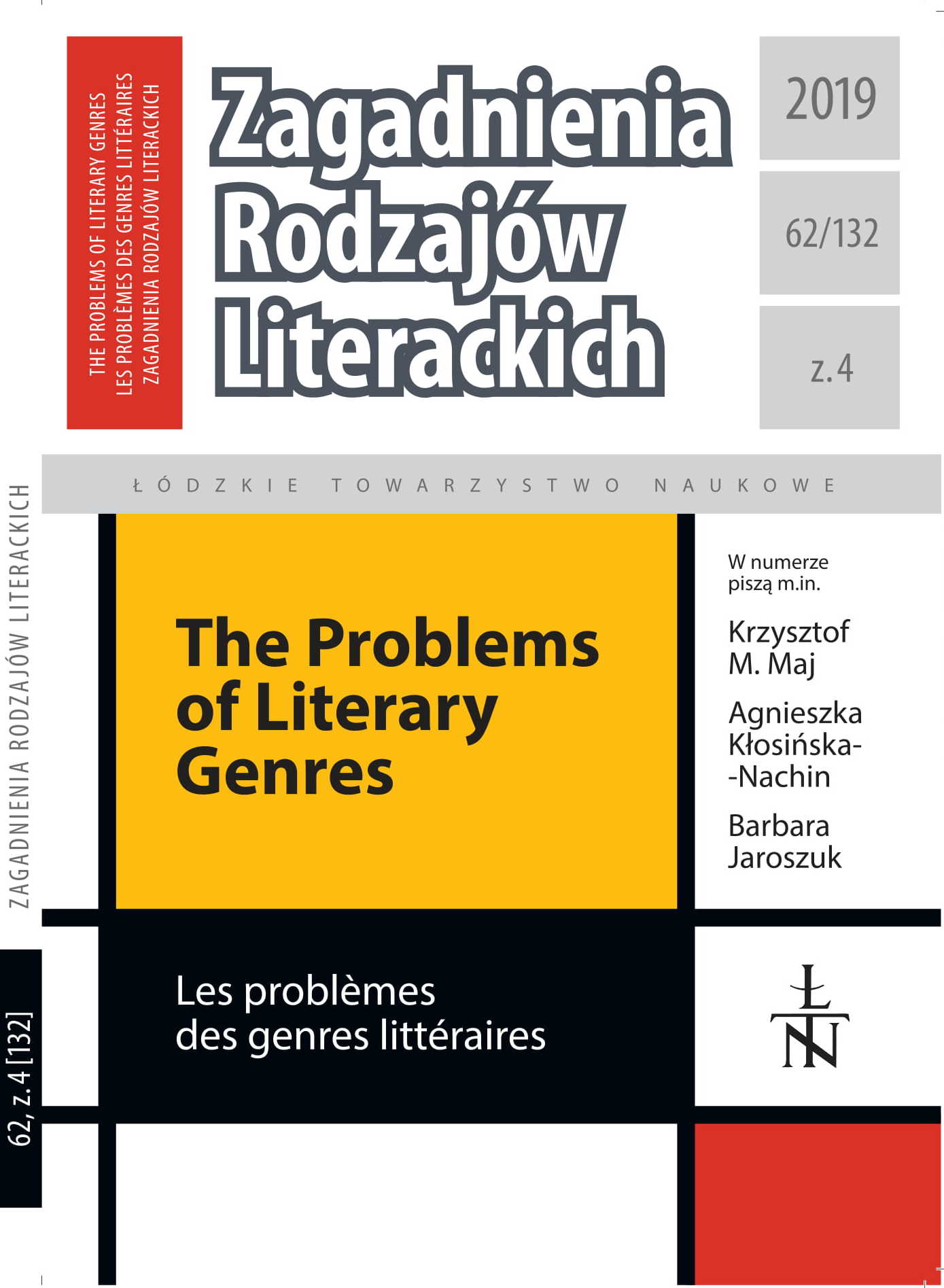Joanna Bator’s (Novelistic) Fiction / Works in the Light of the Theory of Conceptual Integration / Blending
DOI:
https://doi.org/10.26485/ZRL/2019/62.4/6Keywords:
conceptual intergration in Polish literature, blends in Joanna’s Bator novels, relationship between creative writing and the conceptual integration, creative writing in cognitive sciencesAbstract
The theory of conceptual integration / blending is a methodology that enables decoding of complex semantic structures. It not only allows to correctly read hidden meanings of polysemantic concepts, but also to analyse how these structures were created. The concept of blending is useful not only for researchers (especially in the interpretation of numerous cultural texts), but also for authors at the stage of creating their works. An appropriate process of blending guarantees the creation of new, original qualities resulting from a combination of several conceptual structures into one and it also enables the expression of ideas difficult to articulate. The examples of such multidimensional concepts can be found in the novels of Joanna Bator (the laureate of Nike Award in 2013), who (being a cultural expert and anthropologist) tackles in her works various philosophical or sociological issues. She presents her critical observations as specific — metaphorical, metonymic, symbolic and blended — images. This article provides several such examples in order to present how creating and reading blends is connected with “watching” and creative writing as well as sensual and rational exploration of things/meanings in culture.
Downloads
References
Barrie James Matthew (2018), Piotruś Pan, przeł. M. Rusinek, Wilga, Warszawa.
Bator Joanna (2009), Piaskowa Góra, Wydanie I, W.A.B, Warszawa.
— (2010), Chmurdalia, Wydanie I, W.A.B, Warszawa.
Caroll Lewis (1988), Alicja w krainie czarów, przeł. A. Marianowicz, Nasza Księgarnia, Warszawa.
Coulson Seana (2001), Semantics Leaps: Frame-Shifting and Conceptual Blending in Meaning Constructions, Cambridge UP, Cambridge–New York.
Czechowicz Jarosław (2010), „Chmurdalia” Joanna Bator, Krytycznymokiem.blogspot.com, http://krytycznymokiem.blogspot.com/2010/05/chmurdalia-joanna-bator.html [dostęp: 17.10.2018].
Dygat Stanisław (1983), Różowy kajecik [w:] tegoż, Upiór, Wydawnictwo Literackie, Kraków.
Fauconnier Gilles (1994), Mental Spaces: Aspects of Meaning Construction in Natural Language, The MIT Press, Cambridge.
— (1997), Mappings in Thought and Language, Cambridge UP, Cambridge.
Fauconnier Gilles, Turner Mark (2002), The Way We Think: Conceptual Blending and the Mind’s Hidden Complexities, Basic Books, New York.
Gałczyński Konstanty Ildefons (1962), Liryka, liryka, tkliwa dynamika [w:] Liryka, PIW, Warszawa.
Herder Johann Gottfried (1991), Leksykon symboli, przeł. J. Prokopiuk, ROK, Warszawa.
Hudyma Aleksandra (2011), Recenzja książki Joanny Bator „Chmurdalia”, Kultura.onet.pl, https://kultura.onet.pl/wiadomosci/recenzja-chmurdalia-joanna-bator/c5s52wz [dostęp: 17.10.2018].
Król Zofia (2012), Joanna Bator, „Ciemno, prawie noc”, Dwutygodnik.com, https://www.dwu-tygodnik.com/artykul/4072-joanna-bator-ciemno-prawie-noc.html [dostęp: 17.10.2018].
Kurkiewicz Juliusz (2010), Joanna Bator: Saga na opak, Wyborcza.pl, https://wyborcza.pl/1,75410,7958784,Joanna_Bator__Saga_na_opak.html [dostęp: 17.10.2018].
Lakoff George, Johnson Mark (1980), Metaphors We Live By, , Chi¬University of Chicago Presscago.
Leśmian Bolesław (1992), Szczęście, Dom Wydawniczy Pergamon, Tychy.
Libura Agnieszka (2007), Amalgamaty kognitywne. Powstanie i rozwój koncepcji integracji poję¬ciowej [w:] Amalgamaty kognitywne w sztuce, red. A. Libura, Universitas, Kraków.
— (2010), Teoria przestrzeni mentalnych i integracji pojęciowej. Struktura modelu i jego funkcjo¬nalność, Wydawnictwo UWr, Wrocław.
Matuszek Gabriela, Sieja-Skrzypulec Hanna (2015), Twórcze pisanie w teorii i praktyce, Księgar¬nia Akademicka, Kraków.
McLeish Kenneth (1998), Arystoteles: poetyka Arystotelesa, przeł. J. Hołówka, Amber, Warszawa.
Płuciennik Jarosław (2000), Retoryka wzniosłości w dziele literackim, Universitas, Kraków.
— (2002), Figury niewyobrażalnego, Universitas, Kraków.
Reale Giovanni (2005), Historia filozofii starożytnej, tom II, przeł. E.I. Zieliński, Wydawnictwa KUL, Lublin.
Rembowska-Płuciennik Magdalena (2009), Wizualne efekty i afekty: obrazowanie mentalne a emocjonalne zaangażowanie czytelnika, „Teksty Drugie: teoria literatury, krytyka, inter¬pretacja” nr 6.
— (2012), Poetyka intersubiektywności. Kognitywna teoria narracji a proza XX wieku, Wyd. UAM, Toruń.
Ricoeur Paul (1985), Objawienie a powiadomienie [w:] Egzystencja i hermeneutyka. Rozprawy o metodzie, przeł. J.M. Godzimirski, DeAgostini, Warszawa.
Rorty Richard (2009), Przygodność, ironia i solidarność, przeł. W.J. Popowski, W.A.B, Warszawa.
Turner Mark (1996), The Literary Mind, Oxford UP, Oxford.
Ulicka Danuta (2017), Literaturoznawcze dyskursy możliwe, Studia z dziejów nowoczesnej teorii literatury w Europie środkowo-wschodniej, Universitas, Kraków.







